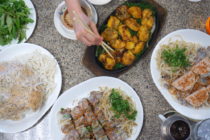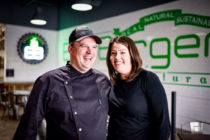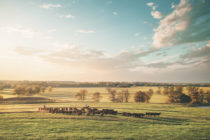It began with a childhood ritual: A boy who helped his grandmother cook every Saturday. The boy, born in Ethiopia but adopted by a Swedish family after his mother’s death, would grow up to be the world-renowned chef, Marcus Samuelsson. Besides becoming the youngest chef to ever earn a coveted three-star rating from The New York Times, at 24, Samuelsson went on to cook for White House State dinners and opened the beloved Red Rooster in Harlem.
Currently on a national book tour, Samuelsson taught a cooking class yesterday at Central Market Houston, along with a book signing of his new book, Yes, Chef: A Memoir. It was a busy day for Samuelsson, who also cooked and ate with a lucky group of guests at the Hofheinz House at a lunch co-hosted by Seth Siegel-Gardner and Terrence Gallivan of the not-yet-open The Pass and Provisions.
We spoke with Samuelsson about his struggle to find a place for himself in the kitchen and the world.
How do you balance your Swedish and Ethiopian heritages in your food and culinary style?
I always cook with Ethiopian spices and sensibility – my lamb hash pretty much sums up my blending of flavors. The dish includes pickled beets and potato. Both cuisines work well when you cook with your soul. I touch my Swedish side whenever I pickle and preserve anything, and I show my Ethiopian soul when I make a dish spice-driven.
Can you share a fond food memory from your grandmother Helga, who was your inspiration?
She taught me about rustic food – her meatballs weren’t round, but they were delicious. She taught me to appreciate different cuts of meats. She showed me the joy in cooking. My sister and I always raced to see who could stack up the jars of lingonberry jam in the pantry. My grandmother made cooking and eating fun.
Do you have a favorite dish?
Something I’m not good at but love to eat is Texas barbecue. It’s a cuisine that I still have a lot to learn about. In Sweden, we ate well without being rich, using what was available. It was fish every day; pickling and preserving were necessities. Today, it’s a taste profile. I see the Texas barbecue culture like that: You can eat well without it costing a lot of money. Maybe I’ll get some [barbecue] tips while I’m here!
What do you think about today’s food scene?
This is the most exciting time to be a chef – and to be a diner, too. Food is not going backward, it’s going forward. While respecting the past, we are also inventing new things for the future. Nine-11 and the economic downturn changed how I cook and how the public wants to dine; they’re looking for more communal, more affordable experiences. That was my whole intention in opening Red Rooster in Harlem. I wanted to break the idea that great food has to cost a lot of money. I used to cook for the one percent; now I cook for the 95 percent.
Cooking shows such as Chopped and Iron Chef are extremely popular these days, and you have been both contestant and judge on them. Which do you prefer?
I enjoy and love being a judge because you can coach someone, but my favorite part is competing and cooking because all the pressure is on you. It’s always exciting but it’s intense. It’s a privilege for a chef to have different sorts of interactions with the public. The book signings are also fun, but where I’m really most comfortable is right here, cooking for you.
See today’s giveaway (below) for a chance to win a copy of chef Marcus Samuelsson’s just-published memoir, Yes, Chef.









Follow Us